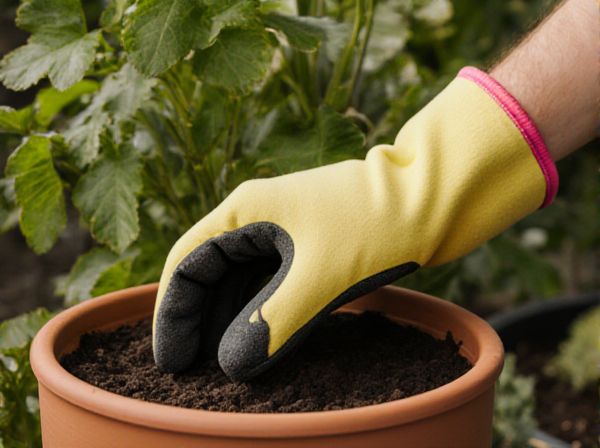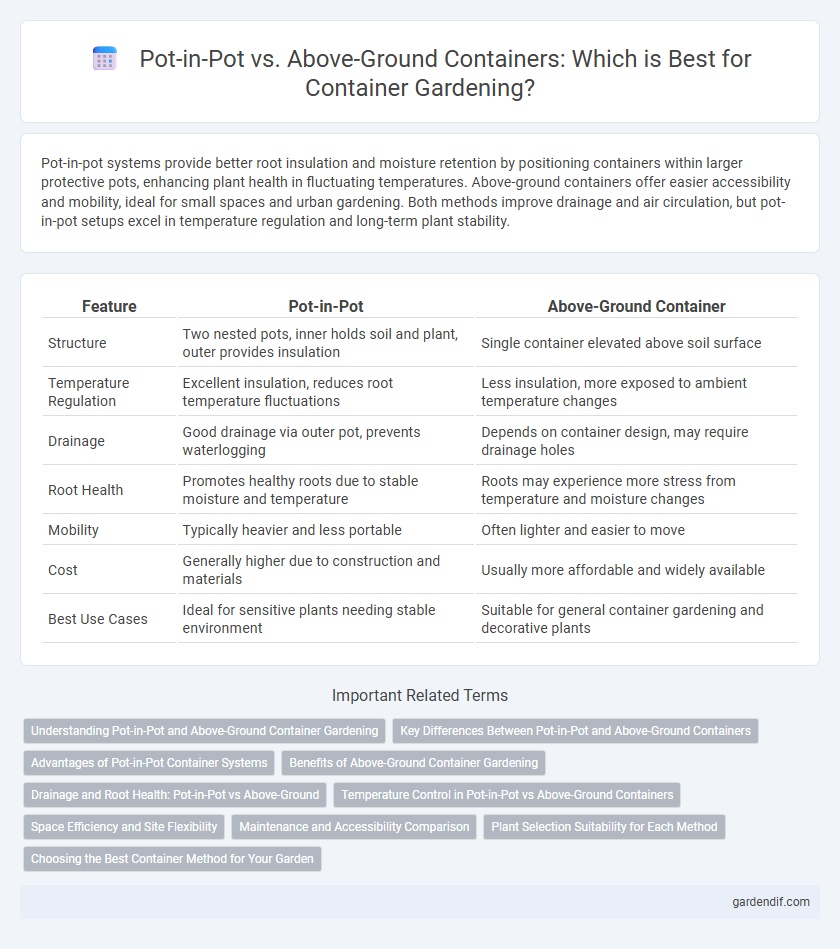
Pot-in-pot vs above-ground container Illustration
Pot-in-pot systems provide better root insulation and moisture retention by positioning containers within larger protective pots, enhancing plant health in fluctuating temperatures. Above-ground containers offer easier accessibility and mobility, ideal for small spaces and urban gardening. Both methods improve drainage and air circulation, but pot-in-pot setups excel in temperature regulation and long-term plant stability.
Table of Comparison
| Feature | Pot-in-Pot | Above-Ground Container |
|---|---|---|
| Structure | Two nested pots, inner holds soil and plant, outer provides insulation | Single container elevated above soil surface |
| Temperature Regulation | Excellent insulation, reduces root temperature fluctuations | Less insulation, more exposed to ambient temperature changes |
| Drainage | Good drainage via outer pot, prevents waterlogging | Depends on container design, may require drainage holes |
| Root Health | Promotes healthy roots due to stable moisture and temperature | Roots may experience more stress from temperature and moisture changes |
| Mobility | Typically heavier and less portable | Often lighter and easier to move |
| Cost | Generally higher due to construction and materials | Usually more affordable and widely available |
| Best Use Cases | Ideal for sensitive plants needing stable environment | Suitable for general container gardening and decorative plants |
Understanding Pot-in-Pot and Above-Ground Container Gardening
Pot-in-pot gardening maximizes root insulation and moisture retention by placing a smaller pot inside a larger one, reducing soil temperature fluctuations and enhancing plant health. Above-ground containers, often elevated or on stands, provide improved drainage and accessibility, ideal for urban or limited-space gardening. Selecting between these methods depends on specific plant needs, climate conditions, and available space, optimizing growth and yield in container gardening.
Key Differences Between Pot-in-Pot and Above-Ground Containers
Pot-in-pot containers are partially buried in the ground, offering superior insulation and moisture retention compared to above-ground containers, which sit entirely above the soil surface. Above-ground containers provide easier access and better drainage but may require more frequent watering and temperature management. The choice between these container types impacts plant health, root development, and overall maintenance requirements in gardening and landscaping.
Advantages of Pot-in-Pot Container Systems
Pot-in-pot container systems offer superior root insulation, maintaining consistent soil temperatures that promote healthier plant growth compared to above-ground containers. These systems enhance water retention and drainage efficiency, reducing the risk of root rot and drought stress. Their design also facilitates easy transplanting and garden organization, making them ideal for nursery operations and home gardeners seeking optimal plant health.
Benefits of Above-Ground Container Gardening
Above-ground container gardening offers superior soil drainage and temperature control, reducing root rot and promoting healthier plant growth. These containers provide greater accessibility for planting and maintenance, ideal for gardeners with limited mobility. Elevated containers also minimize pest challenges and allow for efficient space utilization in small or urban gardens.
Drainage and Root Health: Pot-in-Pot vs Above-Ground
Pot-in-pot containers offer superior drainage by elevating the inner pot, allowing excess water to escape and reducing root rot risk compared to above-ground containers, which often retain water at the bottom. Improved aeration in pot-in-pot systems promotes healthier root development by preventing soil compaction and waterlogging. Above-ground containers require careful monitoring of moisture levels to maintain optimal root health, as poor drainage can lead to fungal diseases and stunted growth.
Temperature Control in Pot-in-Pot vs Above-Ground Containers
Pot-in-pot systems excel in temperature regulation by insulating roots from extreme heat and cold, maintaining a stable microclimate that protects plant health. Above-ground containers are more exposed to ambient temperature fluctuations, often resulting in quicker soil temperature changes that can stress plants. The dual-layer insulation of pot-in-pot containers reduces thermal shock, promoting consistent growth conditions and minimizing root damage.
Space Efficiency and Site Flexibility
Pot-in-pot systems optimize space by allowing multiple plants to be grown vertically within underground containers, reducing surface area usage and improving site flexibility in tight urban gardens. Above-ground containers offer mobility and ease of rearrangement, accommodating various site conditions without permanent installation constraints. Both methods enhance container gardening efficiency, with pot-in-pot excelling in space-saving and above-ground containers providing versatile placement options.
Maintenance and Accessibility Comparison
Pot-in-pot systems require less frequent watering and minimize root exposure to temperature fluctuations, reducing maintenance efforts compared to above-ground containers. Their semi-buried design improves root insulation and stability, enhancing plant health with minimal upkeep. Above-ground containers offer easier accessibility for pruning and harvesting but often demand more consistent watering and monitoring to prevent overheating and drying out.
Plant Selection Suitability for Each Method
Pot-in-pot systems excel with plants requiring stable root temperatures and consistent moisture, such as tomatoes and peppers, due to their insulated, buried outer container. Above-ground containers suit drought-tolerant or shallow-rooted species like succulents and herbs, benefiting from faster soil warming and improved drainage. Choosing the right container type optimizes growth conditions based on each plant's specific root zone and moisture needs.
Choosing the Best Container Method for Your Garden
Pot-in-pot systems enhance root health by promoting natural temperature regulation and improved drainage compared to above-ground containers. Above-ground containers offer versatility in placement and ease of mobility but may require more frequent watering and insulation management. Selecting the best container method depends on plant type, climate conditions, and maintenance preferences to optimize growth and yield.
Pot-in-pot vs above-ground container Infographic

 gardendif.com
gardendif.com